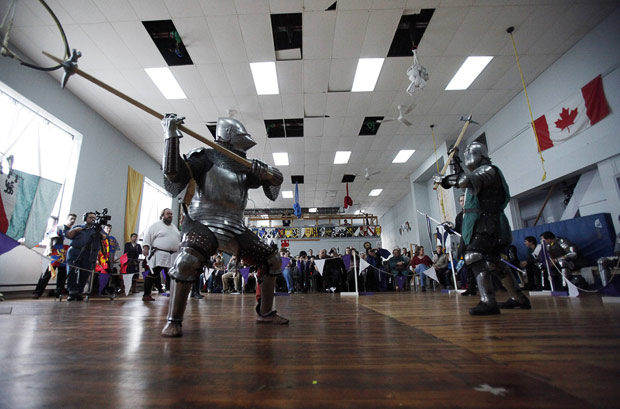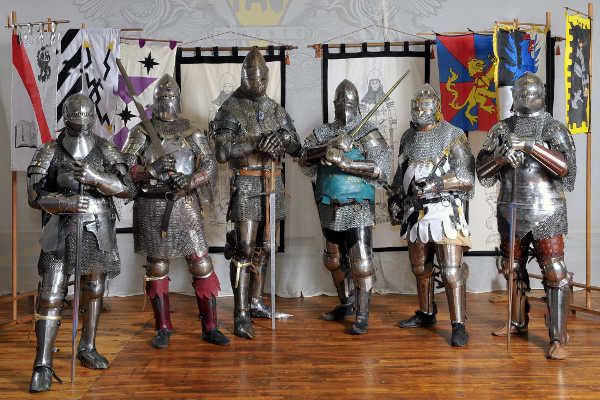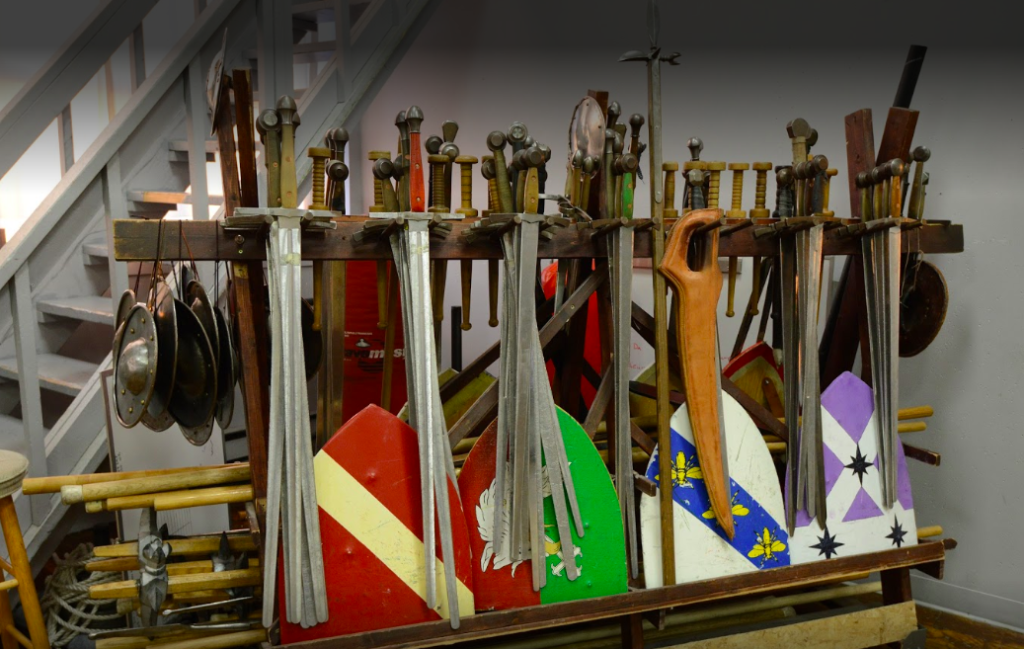By Kashish Hura
The exterior of every building on Dupont Street mirrors the one it neighbours. Exposed red-brick walls, rectangular windows, flat roofs. The quiet streets can fool one because they don’t know that in one of these buildings, a battle is underway.

The building that Fighting Arts Collective, located at 927 Dupont Street, shares with Master Mechanic. Photo credits: Google Images. 
A close-up of the storefront of the Fighting Arts Collective, where the Academy of European Medieval Martial Arts is contained. Photo credits: Google Images
A battle, a dance, an art that Aaron Bolarinho learns and teaches everyday at the Fighting Arts Collective, located on 927 Dupont Street, that houses the Academy of European Medieval Martial Arts.
Neatly trimmed french beard, slicked-back hair, square glasses like a primary school maths teacher’s, that is Aaron Bolarinho. But only during his nine-to-five job at a law firm downtown. After hours, he is at the academy as a fencing instructor. Dressed like a medieval knight in metallic armour from head to toe. Gauntlets to protect his hands, chainmaille breast plates to safeguard his chest from getting stabbed and a silver-plated, rusty helmet shaped like the beak of a crow to shield his face.
“Playing soccer once a week or having any other conventional hobby just wouldn’t have been the same, had I not found this,” Bolarinho says, “My friends may go back home from work and watch politics or play video games but they don’t have a ‘thing’. I do. It’s fencing and it’s mine. My lifelong project.”
Many of his peers from his graduating class now spend their days as academics at a desk, straining their backs, squashed under piles of archival research papers and reports while Bolarinho cheerfully gets all black and blue being hit with daggers and spears all week.
Bolarinho, 31, has been practicing, learning and teaching European martial arts since age 17.
He was ten years old when he attended a workshop called “Forward Into the Past” at Wilfrid Laurier University on the ancient, European art of fencing. “I held onto the event’s poster for six years and when I turned 16, I called them up, they were still alive and running,” Bolarinho continues, “I immediately started training and ever since, it’s been my responsibility to resurrect the Middle Ages for the rest of my life.”
The long-time fencer trained in the academy’s chapter in Kitchener, Ont., until he decided to pursue a degree in Medieval Studies at University of Toronto and further himself in the medieval martial arts simultaneously at its Toronto chapter.
The Toronto location features the salle d’armes which is the main gym room of the academy where these knights meet every day of the week to resurrect the primitive art of sword-fighting. It is an expansive space with several flags and crests hanging on the upper portion of the high, cement-white walls and a centrally located, vibrantly-coloured crest of the academy. The corners of the salle d’armes is complete with massive trunks, featuring renaissance art hand-painted on them and a rack to hold numerous swords and other weapons. If Dragons and Dungeons were to be made a movie, the Academy would be their prop supplier.
The salle d’arme is also an orchestra, except without any symphonies. Sounds of metallic swords clashing against each other, heavy foot-thumping and weights slamming on the floor. It’s open to interpretation whether it’s euphony or cacophony.
The salle d’arme is also an orchestra, except without any symphonies. Sounds of metallic swords clashing against each other, heavy foot-thumping and weights slamming on the floor. It’s open to interpretation whether it’s euphony or cacophony.At the salle d’armes, students go from being recruits to scholars to provost. Recruits are newcomers to the art, scholars are advanced students allowed to teach the craft and knights in the provost-rank sets the curriculum of the learning pathway at the academy.

Two knights fight in the salle d’armes with their choice of weapons. Photo credits: The Academy of European Medieval Martial Arts 
Scholars dressed in full armour, ready to fight. Photo credits: The Academy of European Medieval Martial Arts
“Taking the scholar test was the most excruciating moment of my life,” Bolarinho says, “you are thrown in the middle of a circle, surrounded by scholars and provosts and made to take an oral exam for the first-half, tested on theory and asked to do different moves which is okay and in the second-half, everyone arms up and you are made to fight everyone in the circle.”
If students pass the test, they’re allowed to finally be off the hook and the scholars acknowledge them as their peer. Then, they invite the student to instruct other students and carry tradition forward. This allows the academy to be a not-for-profit organization.

European martial arts is a 600 year-old tradition and practice and goes beyond picking up a sword, swinging it, and trying to hit somebody. Bolarinho says that it’s both an academic and physical discipline. At the academy, they try to learn how a man from the Middle Ages used the tools and weapons he had and how he used them to defend himself.
The academy bases their learning on four manuscripts written in the late 15th century by Maestro Fiore dei Liberi. Bolarinho takes a book off a dusty mahogany bookshelf with wooden bits chipping away at every corner or so. He raises the text to level his face, blows on the cover of the hefty manuscript and the dust clears up to reveal the words, “Flos duellatorum”.
“That translates to the ‘flower of the battle’,” says Bolarinho. “Every move or act we do in fencing here is based off of his writings and illustrations. There is no definitive way to know if a move or act we do in here is accurate to his instructions.” he says, tracing his fingers along the sepia-textured parchment paper of the manuscript, weakly binded together with golden thread.
Fiore wrote these manuscripts in verse, paying more attention to the poetic poignance and metrical rhythm of his words than their clarity.
Bolarinho holds the book in one hand, flipping pages with the other and then scratches his forehead, laughing under his breath as though thinking of an inside joke. “What we primarily learn from his writings is that he was a bit of a jerk, an asshole.” He lifts the burdensome text to the light, clears his throat and recites the balladry of Fiore.
“‘I have locked you in a low bind and you can’t get out of it no matter how hard you try. I can make you suffer or even kill you. I can very well write a letter on your back and you wouldn’t even be able to see me. You have no sword, you have little honour and your party won’t last long.’”
Bolarinho bursts into hysterical laughter and says, “It’s not an instruction or command. It’s just taunting.”
